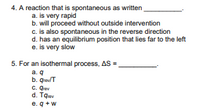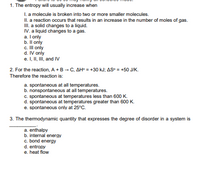
Write your answers only in CAPITAL LETTERS on your answer sheets.
Failure to do so may nullify all scribbles made.
1. The entropy will usually increase when
I. a molecule is broken into two or more smaller molecules.
II. a reaction occurs that results in an increase in the number of moles of gas.
III. a solid changes to a liquid.
IV. a liquid changes to a gas.
a. I only
b. II only
c. III only
d. IV only
e. I, II, III, and IV
2. For the reaction, A + B → C, ΔHo = +30 kJ; ΔSo = +50 J/K.
Therefore the reaction is:
a. spontaneous at all temperatures.
b. nonspontaneous at all temperatures.
c. spontaneous at temperatures less than 600 K.
d. spontaneous at temperatures greater than 600 K.
e. spontaneous only at 25oC.
3. The
__________.
a. enthalpy
b. internal energy
c. bond energy
d. entropy
e. heat flow
4. A reaction that is spontaneous as written __________.
a. is very rapid
b. will proceed without outside intervention
c. is also spontaneous in the reverse direction
d. has an equilibrium position that lies far to the left
e. is very slow
5. For an isothermal process, ΔS = __________.
a. q
b. qrev/T
c. qrev
d. Tqrev
e. q + w
Pleas answer all questions.


Trending nowThis is a popular solution!
Step by stepSolved in 2 steps

- Is this correct?arrow_forwardThe entropy increase in the vaporization of 1.00 mole of bromine is 0.09 kJ/K. If the heat of vaporization is 29.6 kJ/mol, what is the normal boiling point of bromine in deg C? a. 329 b. 2.66 c. 55.7 d. 37.5 e. 29.6arrow_forwardFor a certain process at 455 K, A G=-12.1 kJ and A H=-9.2 kJ. Therefore, A S for the Oa. 6.37 J/K mol process is Ob.0 J/K mol Oc. 3.98 J/K mol d. 8.2 J/K mol O e.-8.2 J/K molarrow_forward
- A reaction carried out in a bomb calorimeter occurs at constant thus the heat transferred corresponds to the change in for the system. a. pressure, internal energy b. volume, internal energy C. volume, enthalpy d. pressure, enthalpy e. temperature, internal energyarrow_forwardThe temperature of an object from which no heat energy can be extracted is a. 0° F b. 0° C c. 0 K d. 100 K e. 100° Carrow_forwardis gas C. solid 3. Which of the following is a A. ripening of fruits B. liquid nonspontaneous process? C. coffee getting colder B. a ball rolling upwards D. a drop of ink dispersing in water 4. What happens to entropy when solid carbon dioxide (dry ice) sublimes? A. It decreases B. it increases C. It stays the same D. cannot be determined 5. What is the value for standard temperature and pressure or STP? A. 25°C and 10 atm B. 25°C and 1 atm C. 100°C and 1 atm D. 32°C and 10 atm 6. Who is the proponent of the Gibbs free energy? A. William Friedrich B. Guglielmo Marconi C. William Gibbs D. Janno Gibbs 7. When AG H2(g) = 130.6, 12 (s) = 116.7 and Hl (g) = 206.3 A. AS = +165.3 J/K B. AS = -165.3 J/K C. AS = -41 J/K D. AS = +453.6 J/K 9. What value of Gibbs free energy can we safely predict that the reaction is spontaneous at all temperatures? A. a negative value C. a positive value at a low temperature B. a positive value D. a positive value at a high temperature 10. What will be the…arrow_forward
- What is the change in entropy for the vaporization of 27.0 g of H2O at 100°C? At this temperature, the molar enthalpy of vaporization for water is 44.0 kJ/mol. A. 0.660 J/K B. 118 J/K C. 0.177 J/K D. 660 J/K E. 177 J/Karrow_forwardWhich of the following is true ? X. Exothermic reactions are spontaneous because formation of products is favored by decrease of free energy of the system Y. All spontaneous reactions accompanied by increase of entropy of the universum. Z. All spontaneous reactions accompanied by increase of entropy of the system. * Y only * X, Y and Z * Y and Z only * X only * X and Z only * Z only * X and Y only * none of themarrow_forward34. Consider planet Earth as a thermodynamic system. Is Earth thermodynamically or kinetically stable? Discuss your choice, providing two-three arguments.arrow_forward
- The standard molar Gibbs free energy of formation for oxygen gas is: A. −15 kJ mol−1 B. 0 kJ mol−1 C. much larger than ΔfG° of hydrogen gas D. much less than ΔfG° of elemental uranium E. equal to ΔfG° of elemental tungsten F. Both C. and D. G. Both B. and E.arrow_forwardDry nitrogen gas (100.0 L) was bubbled through liquid ethanol, C2H5OH, at a given temperature and the evaporated ethanol condensed; its mass was then measured. Using the data below, calculate the heat of vaporization (kJ/mol) of ethanol?arrow_forwardQ1. A reaction tends to be endergonic when there is a decrease in entropy. the products have less potential energy than the reactants. it is endothermic. the products are less ordered than the reactants. A. 1, 2 and 3 B. 1 and 3 C. 2 and 4 D. 4 only E. All of 1, 2, 3 and 4 are correctarrow_forward
 ChemistryChemistryISBN:9781305957404Author:Steven S. Zumdahl, Susan A. Zumdahl, Donald J. DeCostePublisher:Cengage Learning
ChemistryChemistryISBN:9781305957404Author:Steven S. Zumdahl, Susan A. Zumdahl, Donald J. DeCostePublisher:Cengage Learning ChemistryChemistryISBN:9781259911156Author:Raymond Chang Dr., Jason Overby ProfessorPublisher:McGraw-Hill Education
ChemistryChemistryISBN:9781259911156Author:Raymond Chang Dr., Jason Overby ProfessorPublisher:McGraw-Hill Education Principles of Instrumental AnalysisChemistryISBN:9781305577213Author:Douglas A. Skoog, F. James Holler, Stanley R. CrouchPublisher:Cengage Learning
Principles of Instrumental AnalysisChemistryISBN:9781305577213Author:Douglas A. Skoog, F. James Holler, Stanley R. CrouchPublisher:Cengage Learning Organic ChemistryChemistryISBN:9780078021558Author:Janice Gorzynski Smith Dr.Publisher:McGraw-Hill Education
Organic ChemistryChemistryISBN:9780078021558Author:Janice Gorzynski Smith Dr.Publisher:McGraw-Hill Education Chemistry: Principles and ReactionsChemistryISBN:9781305079373Author:William L. Masterton, Cecile N. HurleyPublisher:Cengage Learning
Chemistry: Principles and ReactionsChemistryISBN:9781305079373Author:William L. Masterton, Cecile N. HurleyPublisher:Cengage Learning Elementary Principles of Chemical Processes, Bind...ChemistryISBN:9781118431221Author:Richard M. Felder, Ronald W. Rousseau, Lisa G. BullardPublisher:WILEY
Elementary Principles of Chemical Processes, Bind...ChemistryISBN:9781118431221Author:Richard M. Felder, Ronald W. Rousseau, Lisa G. BullardPublisher:WILEY





